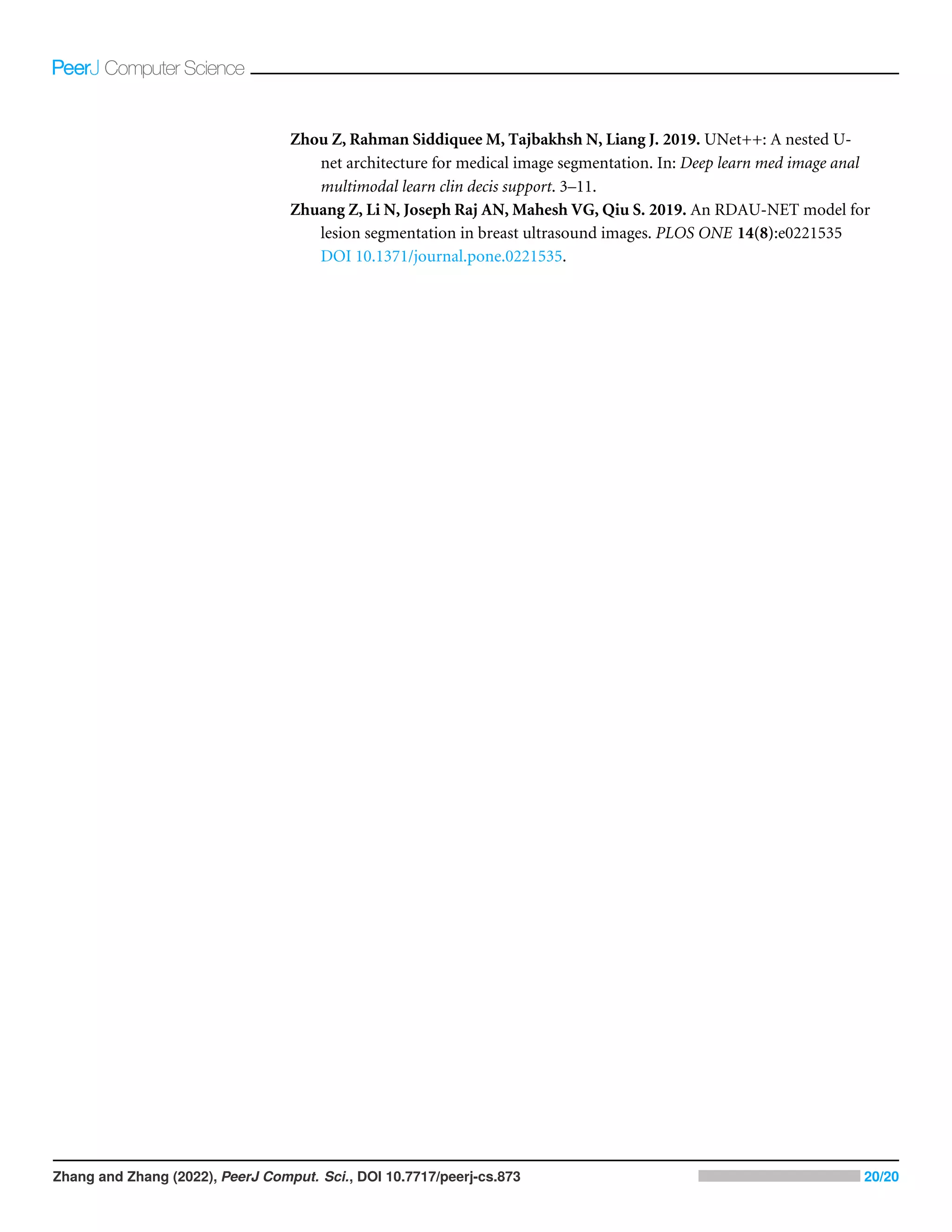The document discusses a novel ultrasound image denoising approach using a Generative Adversarial Network with Residual Dense Connectivity and Weighted Joint Loss (GAN-RW), which aims to effectively reduce speckle noise while maintaining image features. Experimental results demonstrate that GAN-RW outperforms existing denoising algorithms across various metrics, especially in ultrasound images, indicating its advanced performance in clinical diagnostics. The methodology is built on U-Net architecture and incorporates a unique joint loss function for improved training efficacy.


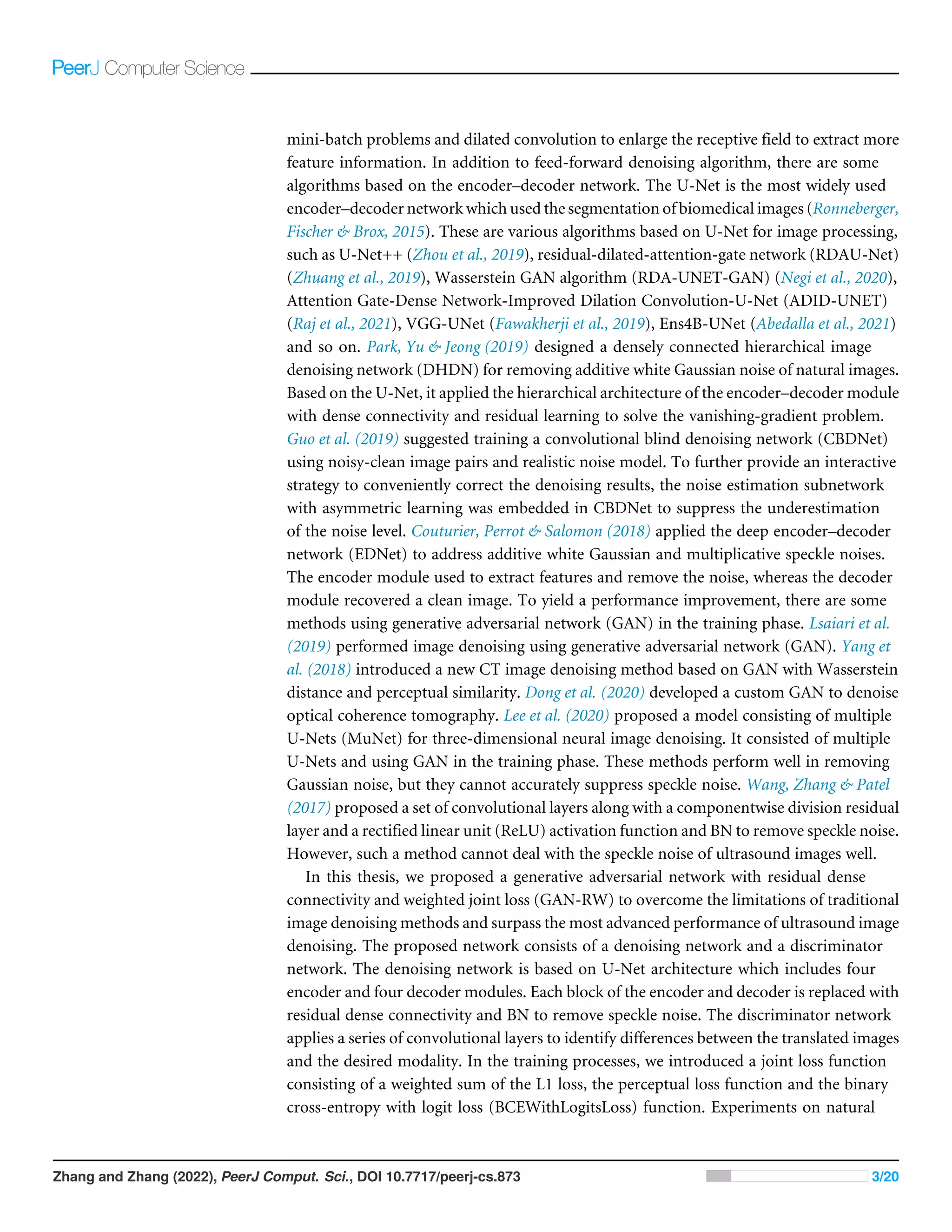
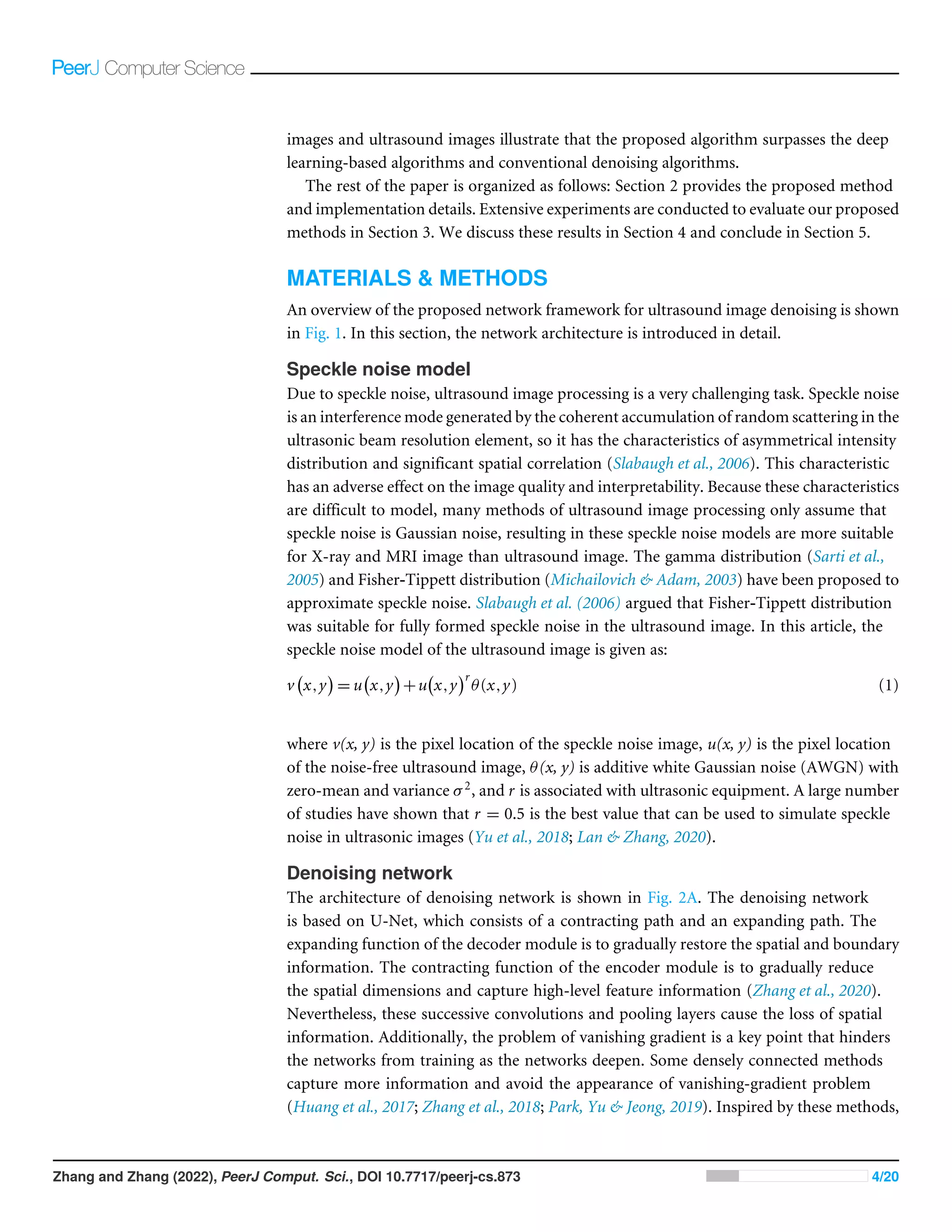
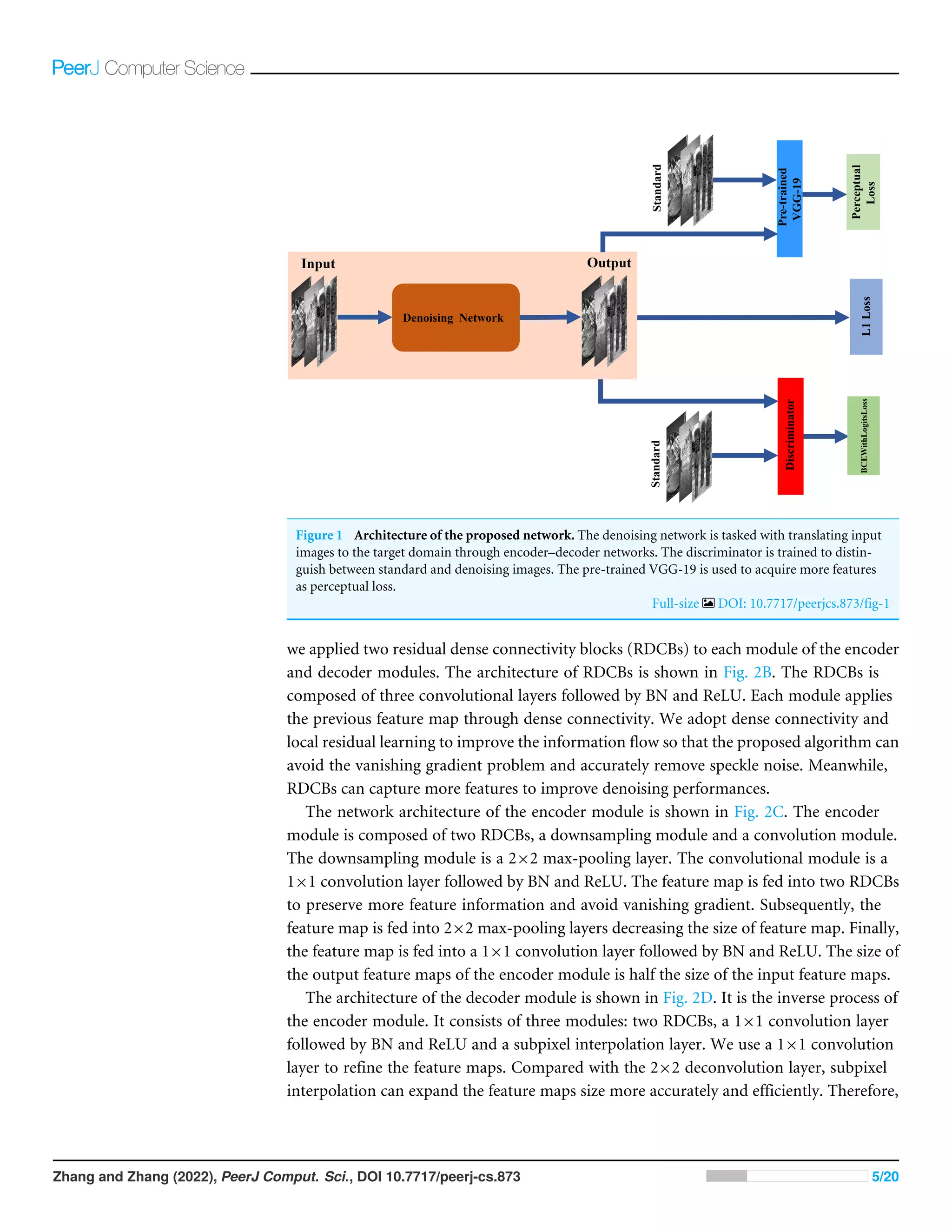
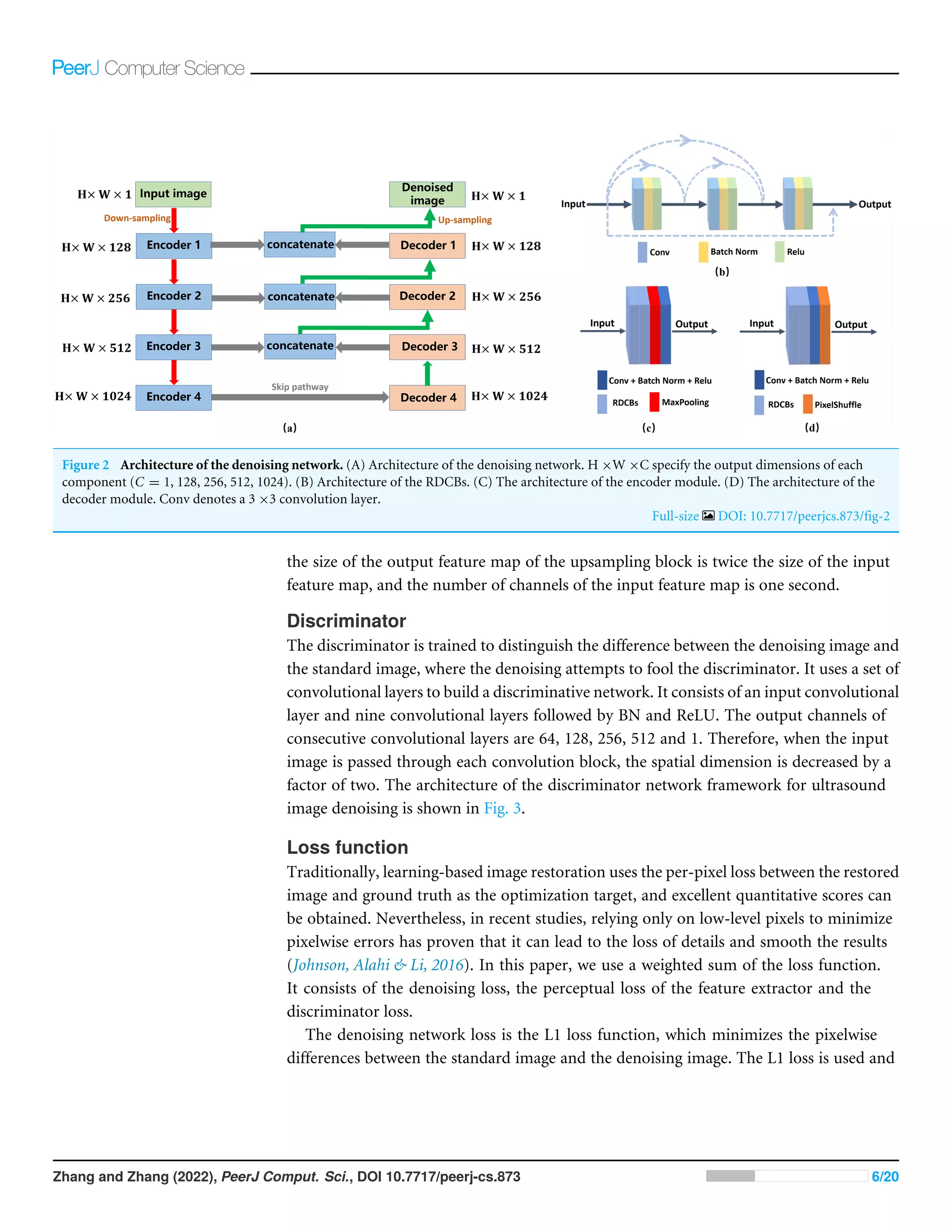
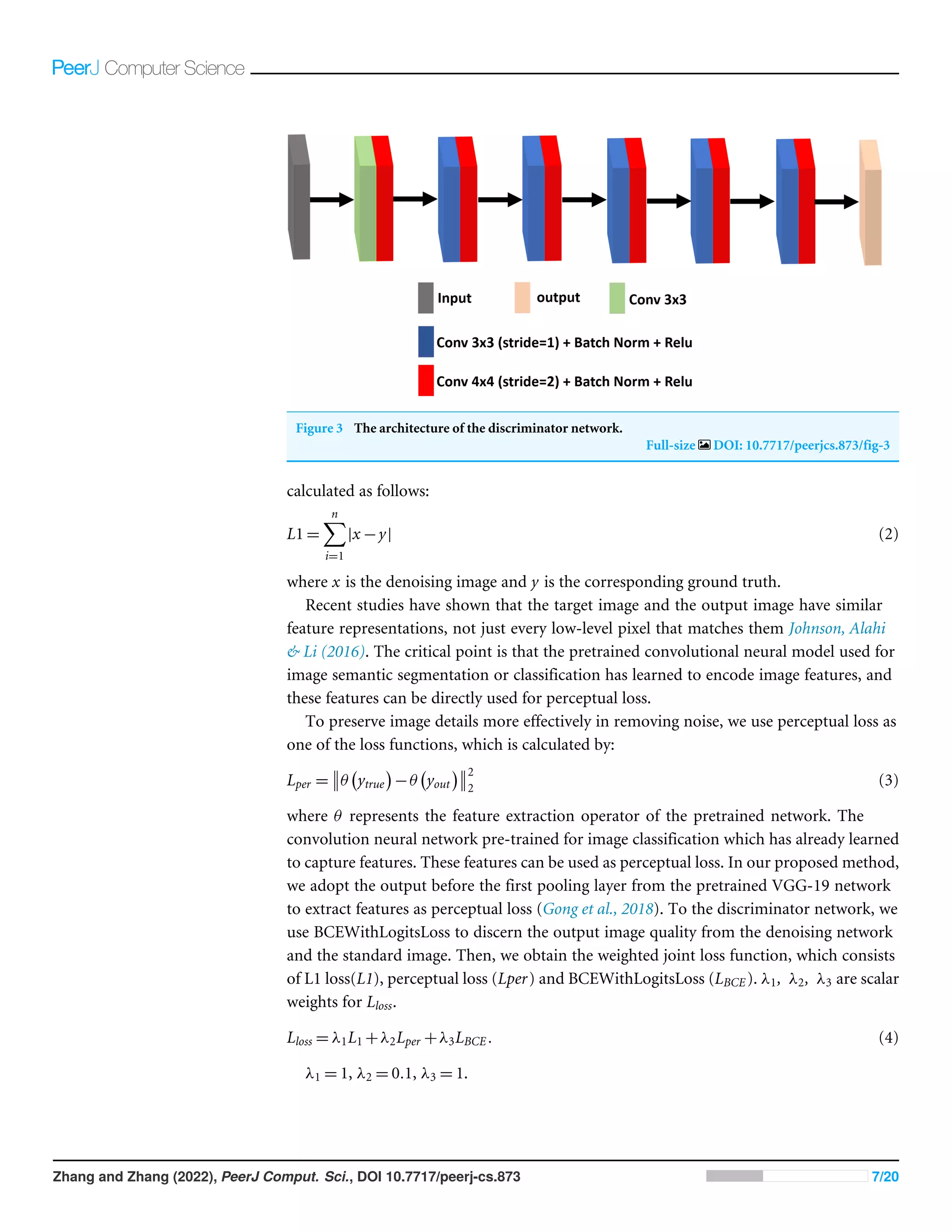
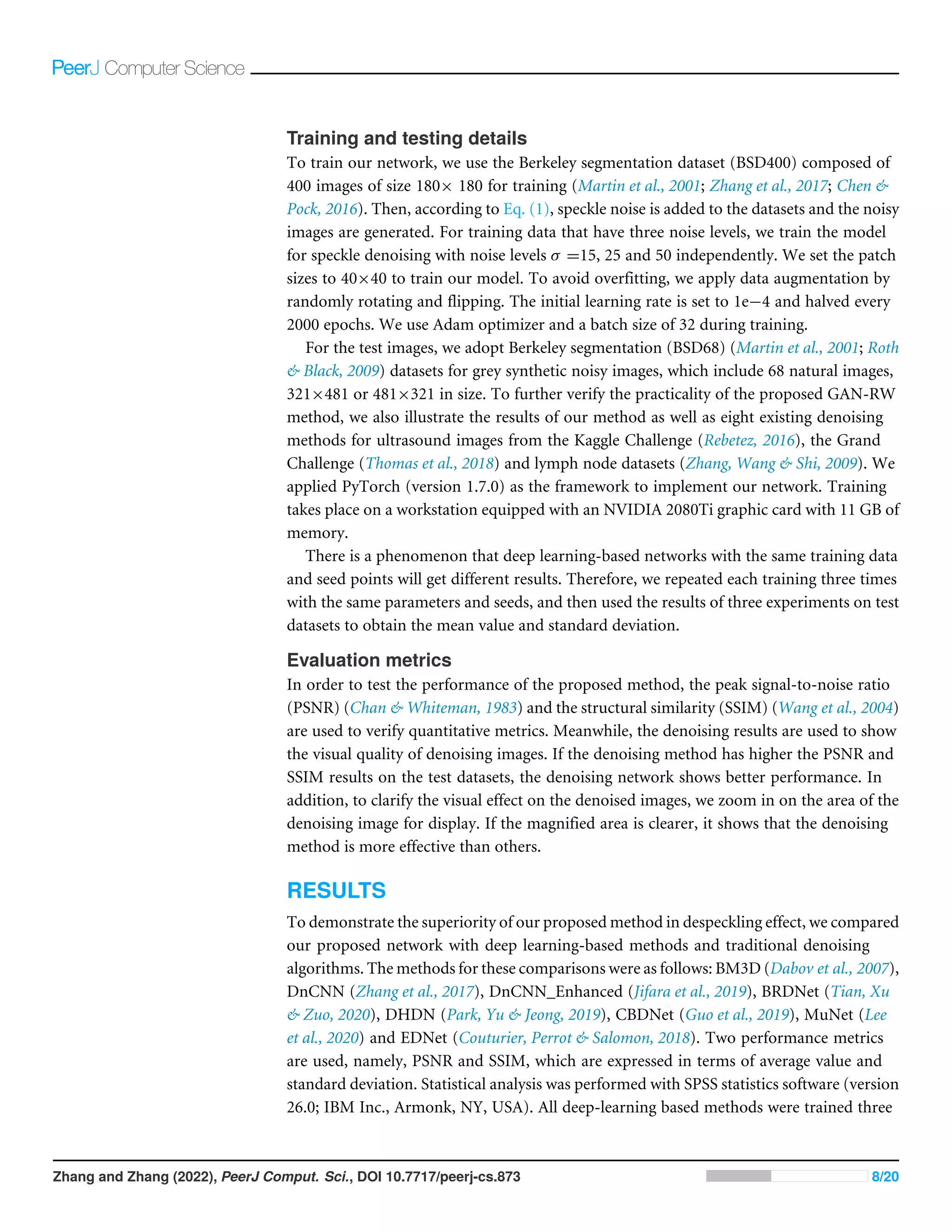

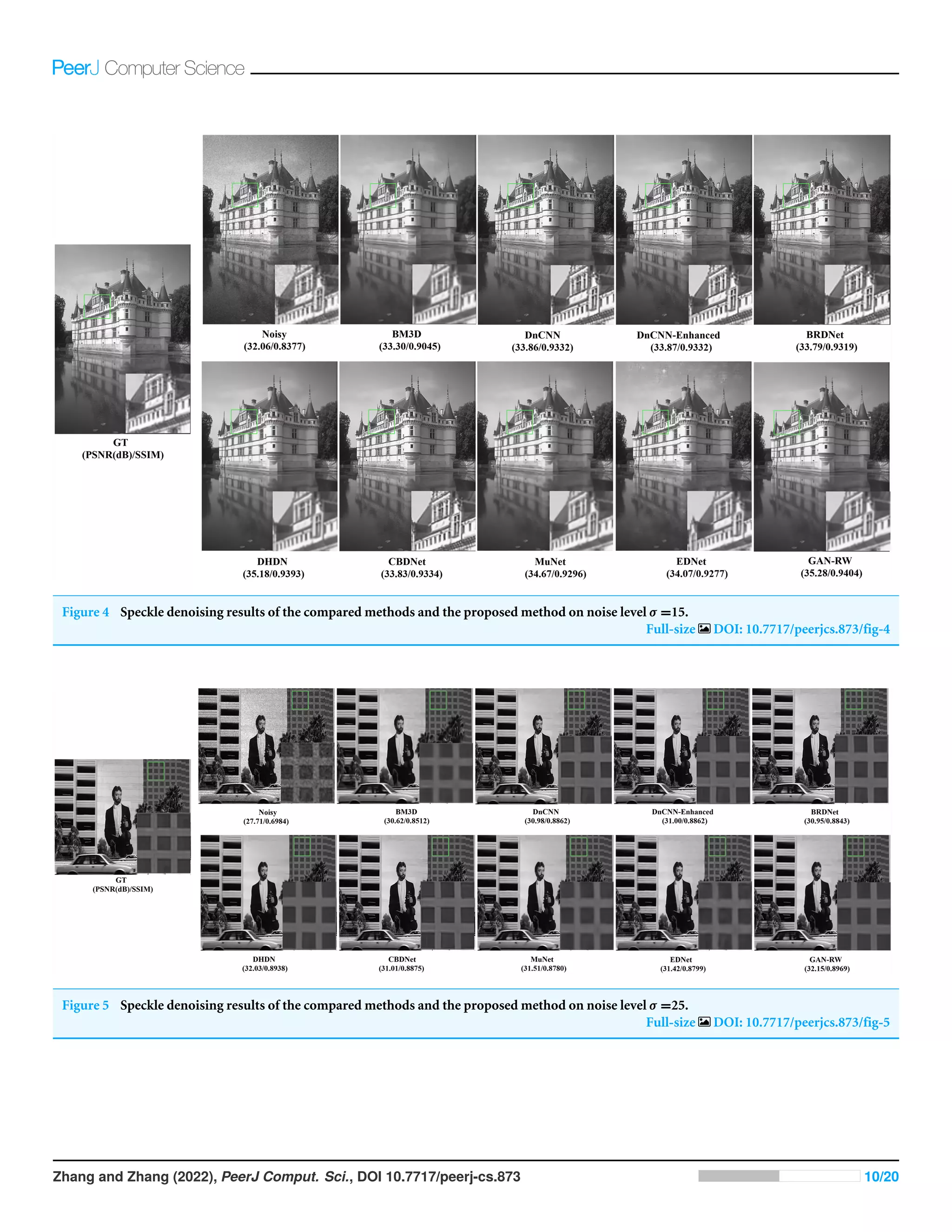
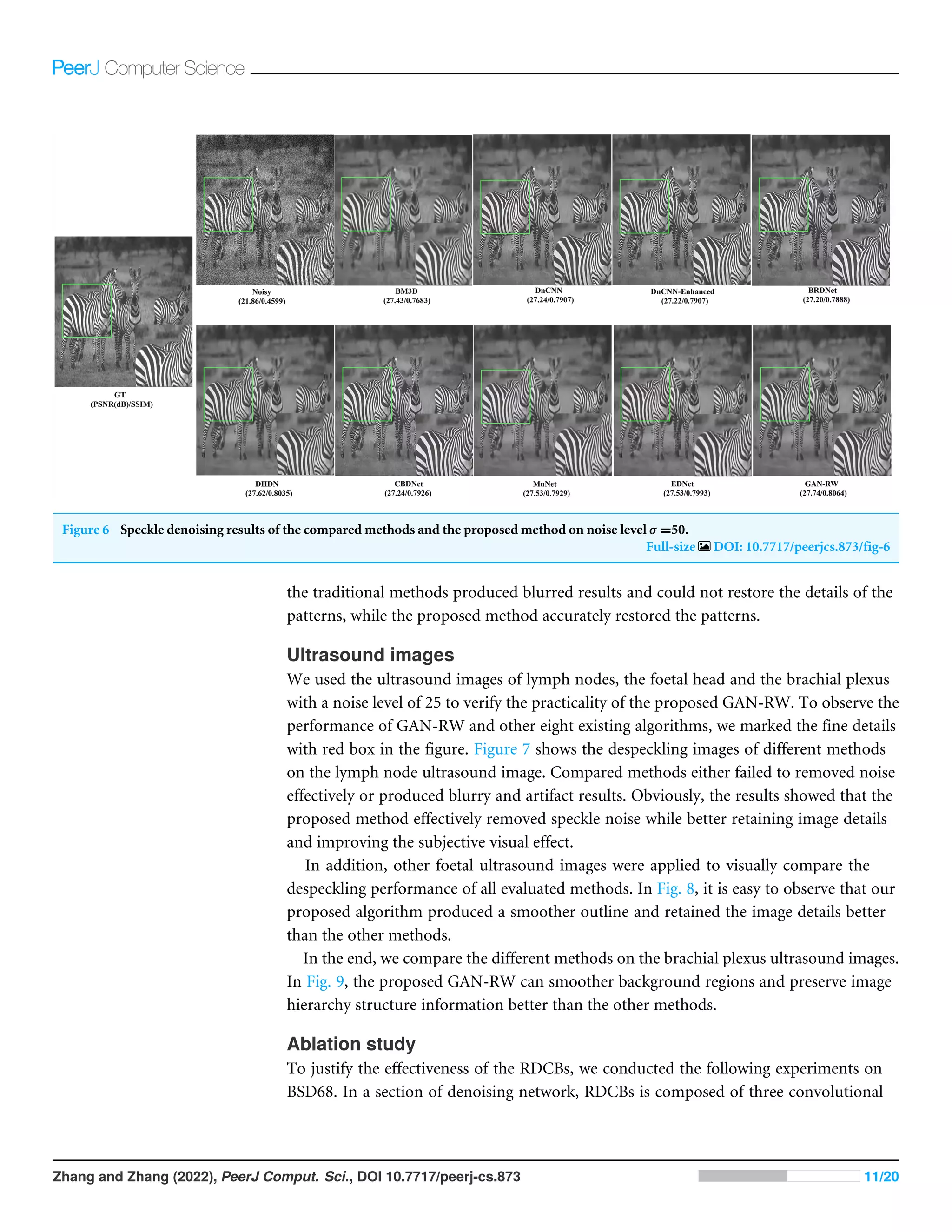

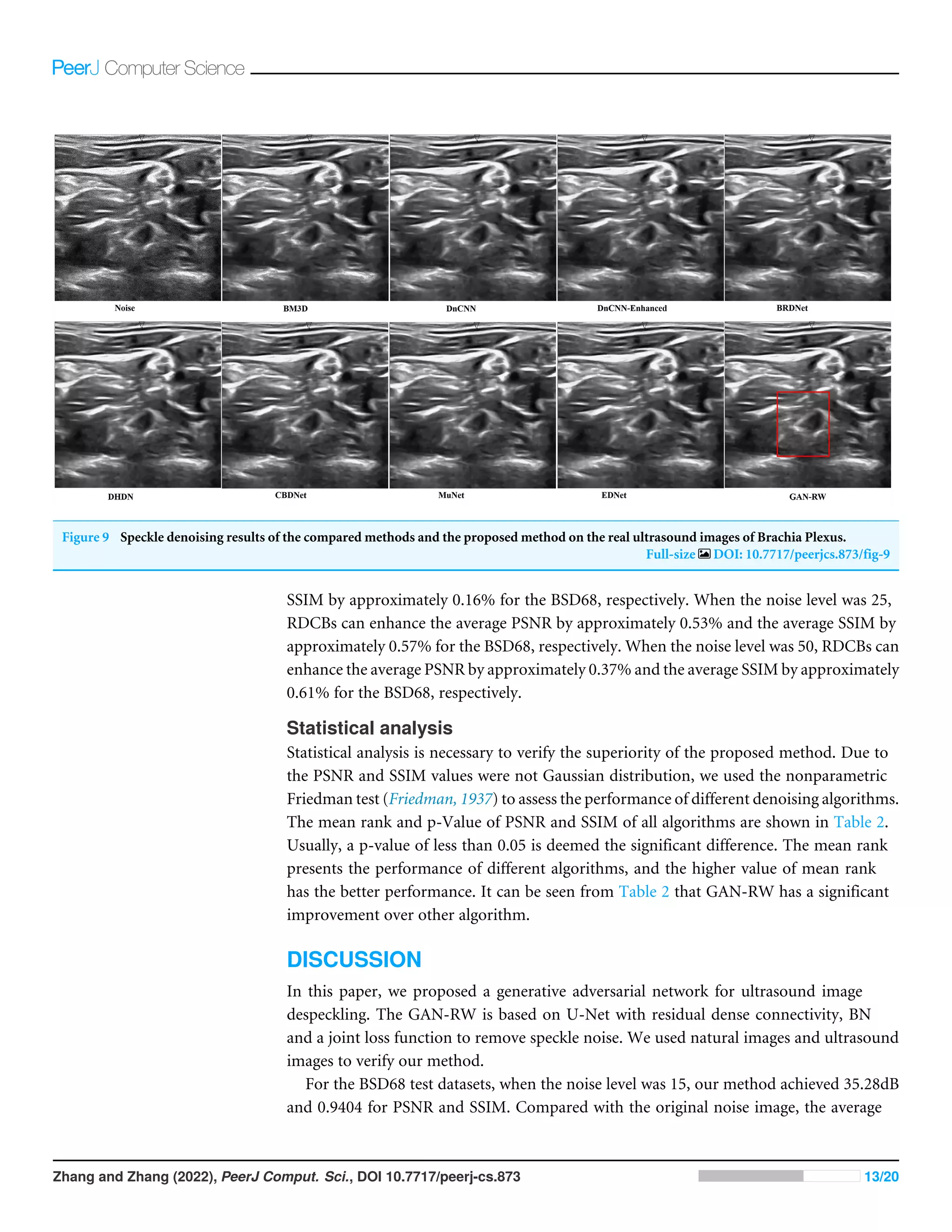

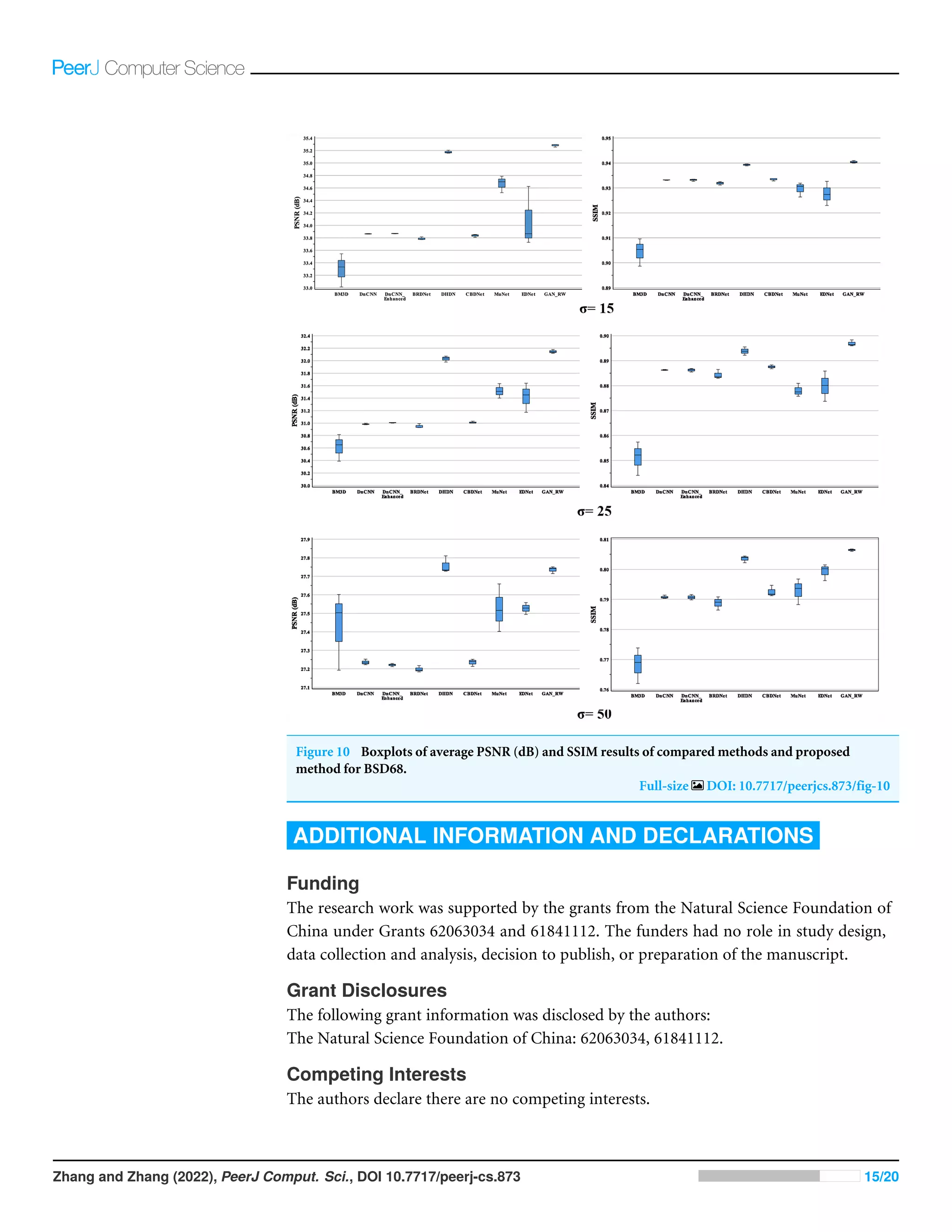
![Author Contributions
• Lun Zhang conceived and designed the experiments, performed the experiments,
analyzed the data, performed the computation work, prepared figures and/or tables,
authored or reviewed drafts of the paper, and approved the final draft.
• Junhua Zhang conceived and designed the experiments, analyzed the data, authored or
reviewed drafts of the paper, and approved the final draft.
Data Availability
The following information was supplied regarding data availability:
The datasets of the BSD400, BSD68 and lymph node are available at GitHub:
https://github.com/smartboy110/denoising-datasets.
The datasets of the foetal head are available at Zenodo: Thomas L. A. van den
Heuvel, Dagmar de Bruijn, Chris L. de Korte, Bram van Ginneken (2018). Automated
measurement of fetal head circumference using 2D ultrasound images [Data set]. Zenodo.
https://doi.org/10.5281/zenodo.1327317.
The datasets of the brachial plexus are available at Kaggle: https://www.kaggle.com/c/
ultrasound-nerve-segmentation.
Figure 5 and the BSD68 figures are available from the Berkeley Segmentation Dataset
and Benchmark (https://www2.eecs.berkeley.edu/Research/Projects/CS/vision/bsds/).
Supplemental Information
Supplemental information for this article can be found online at http://dx.doi.org/10.7717/
peerj-cs.873#supplemental-information.
REFERENCES
Abedalla A, Abdullah M, Al-Ayyoub M, Benkhelifa E. 2021. Chest X-ray pneumothorax
segmentation using U-Net with EfficientNet and ResNet architectures. PeerJ
Computer Science 7:e607 DOI 10.7717/peerj-cs.607.
Buades A, Coll B, Morel JM. 2005. A non-local algorithm for image denoising. In:
Proceedings of the IEEE conference on computer vision and pattern recognition (CVPR),
vol. 2. 60–65.
Chan LC, Whiteman P. 1983. Hardware-constrained hybrid coding of video imagery.
IEEE Transactions on Aerospace and Electronic Systems 1:71–84.
Chen Y, Pock T. 2016. Trainable nonlinear reaction diffusion: a flexible framework
for fast and effective image restoration. IEEE Transactions on Pattern Analysis and
Machine Intelligence 39(6):1256–1272.
Couturier R, Perrot G, Salomon M. 2018. Image denoising using a deep encoder–
decoder network with skip connections. In: International conference on neural
information processing. 554–565.
Dabov K, Foi A, Katkovnik V, Egiazarian K. 2007. Image denoising by sparse 3-D
transform-domain collaborative filtering. IEEE Transactions on Image Processing
16(8):2080–2095 DOI 10.1109/TIP.2007.901238.
Zhang and Zhang (2022), PeerJ Comput. Sci., DOI 10.7717/peerj-cs.873 16/20](https://image.slidesharecdn.com/ultrasoundimagedenoisingusinggenerativeadversarialnetworkswithresidualdenseconnectivityandweightedjo-221118154405-f0a495df/75/Ultrasound-image-denoising-using-generative-adversarial-networks-with-residual-dense-connectivity-and-weighted-joint-loss-pdf-16-2048.jpg)
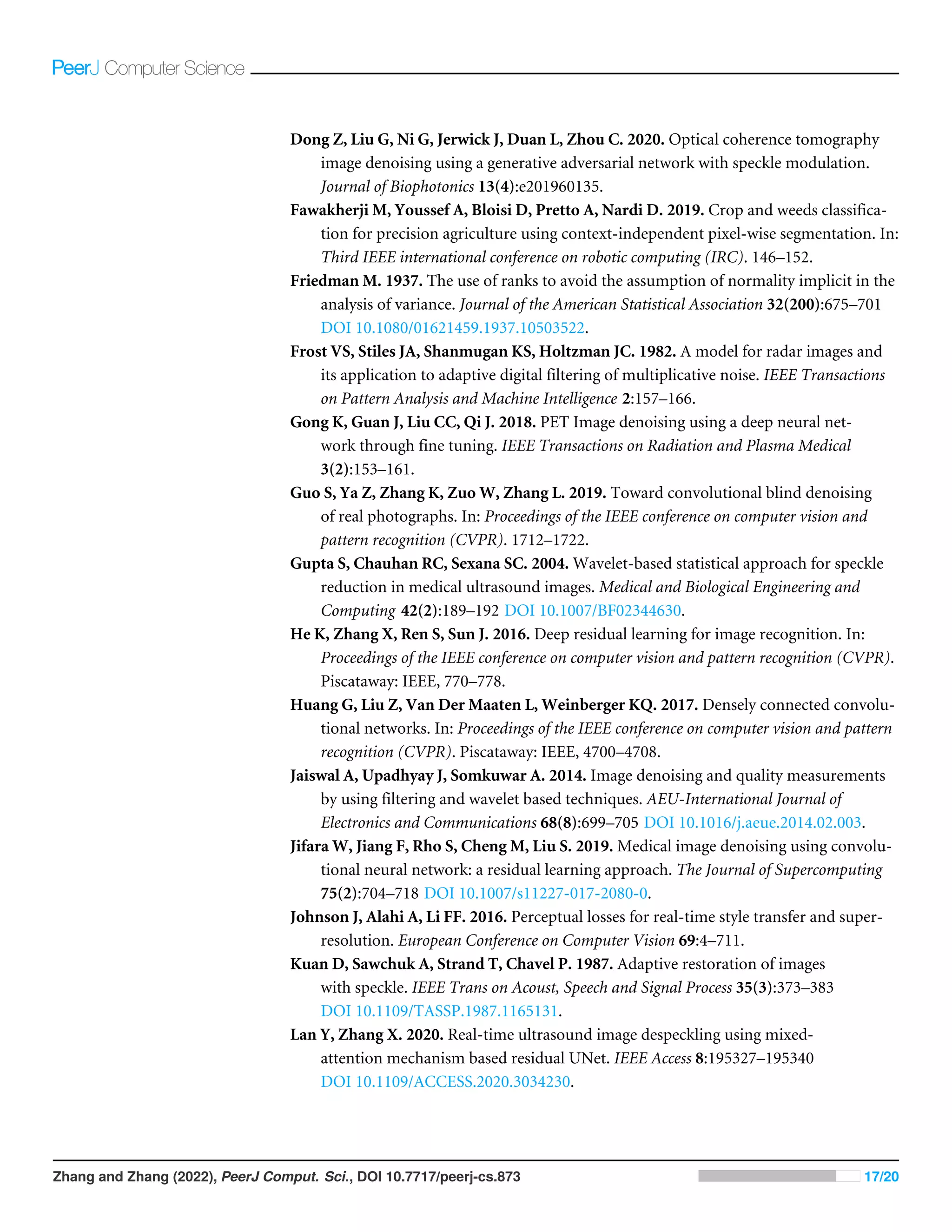
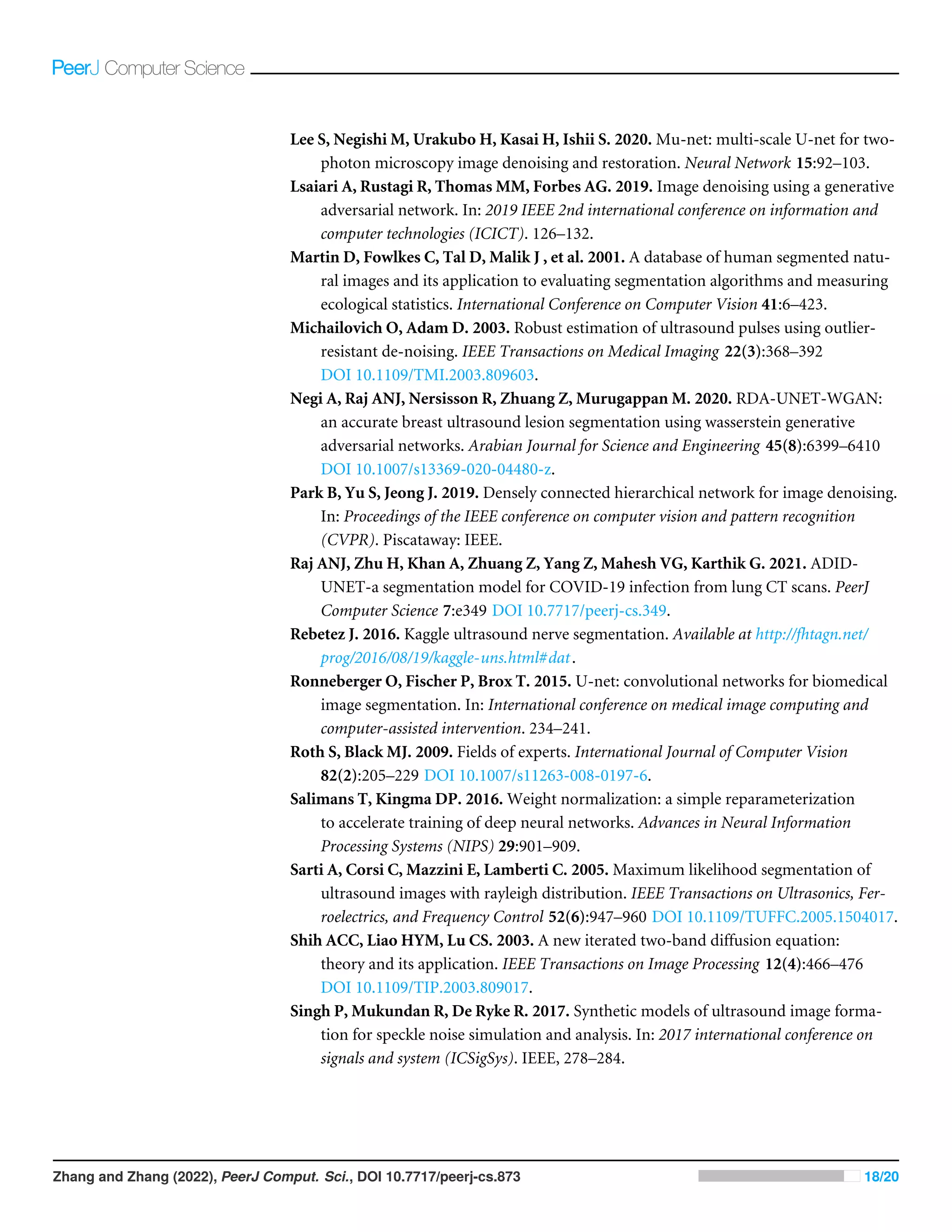
![Slabaugh G, Unal G, Fang T, Wels M. 2006. Ultrasound-specific segmentation via
decorrelation and statistical region-based active contours. In: Proceedings of the IEEE
conference on computer vision and pattern recognition (CVPR), vol. 1. 45–53.
Srivastava M, Anderson CL, Freed JH. 2016. A new wavelet denoising method for
selecting decomposition levels and noise thresholds. IEEE Access 4:3862–3877
DOI 10.1109/ACCESS.2016.2587581.
Thomas LA, Heuvel V, De Bruijn D, De Korte CL, Van Ginneken B. 2018. Automated
measurement of fetal head circumference using 2D ultrasound images [Data set].
Zenodo. DOI 10.5281/zenodo.1322001.
Tian C, Xu Y, Zuo W. 2020. Image denoising using deep CNN with batch renormaliza-
tion. Neural Networks 121:461–473 DOI 10.1016/j.neunet.2019.08.022.
Wang Z, Bovik AC, Sheikh HR, Simoncelli EP. 2004. Image quality assessment: from
error visibility to structural similarity. IEEE Transactions on Image Processing
13(4):600–612 DOI 10.1109/TIP.2003.819861.
Wang P, Zhang H, Patel VM. 2017. SAR image despeckling using a convolutional neural
network. IEEE Signal Processing Letters 24(12):1763–1767
DOI 10.1109/LSP.2017.2758203.
Yang Q, Yan P, Zhang Y, Yu H, Shi Y, Mou X, Wang G. 2018. Low-dose CT image
denoising using a generative adversarial network with Wasserstein distance
and perceptual loss. IEEE Transactions on Medical Imaging 37(6):1348–1135
DOI 10.1109/TMI.2018.2827462.
Yu Y, Acton ST. 2002. Speckle reducing anisotropic diffusion. IEEE Transactions on
Image Processing 11(11):1260–1270 DOI 10.1109/TIP.2002.804276.
Yu H, Ding M, Zhang X, Wu J. 2018. PCANet based nonlocal means method for speckle
noise removal in ultrasound images. PLOS ONE 13(10):e0205390.
Yue Y, Croitoru MM, Bidani A, Zwischenberger JB, Clark JW. 2006. Nonlinear
multiscale wavelet diffusion for speckle suppression and edge enhancement
in ultrasound images. IEEE Transaction on Medical Imaging 25(3):297–311
DOI 10.1109/TMI.2005.862737.
Zhang Y, Tian Y, Kong Y, Zhong B, Fu Y. 2018. Residual dense network for image
restoration. ArXiv preprint. arXiv:1812.10477.
Zhang J, Wang Y, Shi X. 2009. An improved graph cut segmentation method for
cervical lymph nodes on sonograms and its relationship with node’s shape
assessment. Computerized Medical Imaging and Graphics 33(8):602–607
DOI 10.1016/j.compmedimag.2009.06.002.
Zhang L, Zhang J, Li Z, Song Y. 2020. A multiple-channel and atrous convolution
network for ultrasound image segmentation. Medical Physics 47(12):6270–6285
DOI 10.1002/mp.14512.
Zhang K, Zuo W, Chen Y, Meng D, Zhang L. 2017. Beyond a Gaussian denoiser: residual
learning of deep CNN for image denoising. IEEE Transactions on Image Processing
26(7):3142–3155 DOI 10.1109/TIP.2017.2662206.
Zhang and Zhang (2022), PeerJ Comput. Sci., DOI 10.7717/peerj-cs.873 19/20](https://image.slidesharecdn.com/ultrasoundimagedenoisingusinggenerativeadversarialnetworkswithresidualdenseconnectivityandweightedjo-221118154405-f0a495df/75/Ultrasound-image-denoising-using-generative-adversarial-networks-with-residual-dense-connectivity-and-weighted-joint-loss-pdf-19-2048.jpg)
